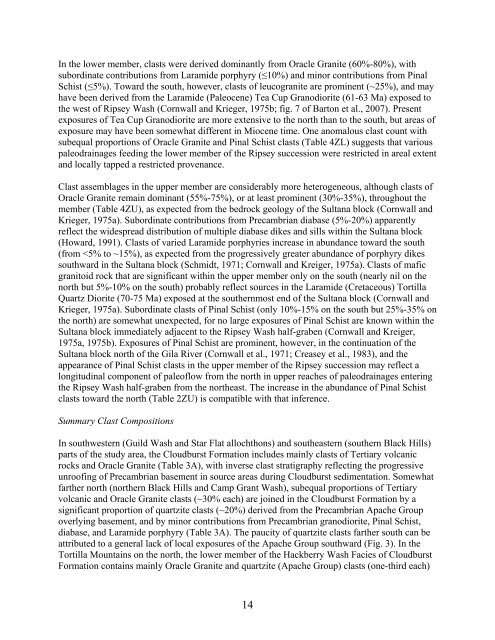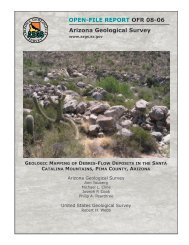Conglomerate Clast Counts in Oligocene-Miocene Strata North
Conglomerate Clast Counts in Oligocene-Miocene Strata North
Conglomerate Clast Counts in Oligocene-Miocene Strata North
You also want an ePaper? Increase the reach of your titles
YUMPU automatically turns print PDFs into web optimized ePapers that Google loves.
In the lower member, clasts were derived dom<strong>in</strong>antly from Oracle Granite (60%-80%), with<br />
subord<strong>in</strong>ate contributions from Laramide porphyry (≤10%) and m<strong>in</strong>or contributions from P<strong>in</strong>al<br />
Schist (≤5%). Toward the south, however, clasts of leucogranite are prom<strong>in</strong>ent (~25%), and may<br />
have been derived from the Laramide (Paleocene) Tea Cup Granodiorite (61-63 Ma) exposed to<br />
the west of Ripsey Wash (Cornwall and Krieger, 1975b; fig. 7 of Barton et al., 2007). Present<br />
exposures of Tea Cup Granodiorite are more extensive to the north than to the south, but areas of<br />
exposure may have been somewhat different <strong>in</strong> <strong>Miocene</strong> time. One anomalous clast count with<br />
subequal proportions of Oracle Granite and P<strong>in</strong>al Schist clasts (Table 4ZL) suggests that various<br />
paleodra<strong>in</strong>ages feed<strong>in</strong>g the lower member of the Ripsey succession were restricted <strong>in</strong> areal extent<br />
and locally tapped a restricted provenance.<br />
<strong>Clast</strong> assemblages <strong>in</strong> the upper member are considerably more heterogeneous, although clasts of<br />
Oracle Granite rema<strong>in</strong> dom<strong>in</strong>ant (55%-75%), or at least prom<strong>in</strong>ent (30%-35%), throughout the<br />
member (Table 4ZU), as expected from the bedrock geology of the Sultana block (Cornwall and<br />
Krieger, 1975a). Subord<strong>in</strong>ate contributions from Precambrian diabase (5%-20%) apparently<br />
reflect the widespread distribution of multiple diabase dikes and sills with<strong>in</strong> the Sultana block<br />
(Howard, 1991). <strong>Clast</strong>s of varied Laramide porphyries <strong>in</strong>crease <strong>in</strong> abundance toward the south<br />
(from

















